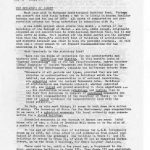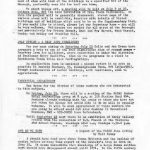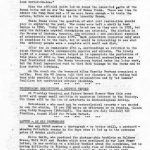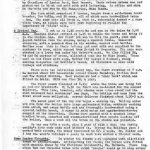Newsletter
Page 1
The buildings of Barnet
Next year will be European Architectural Heritage year. Perhaps you haven’t met that title before — but it is likely to become familiar between now and the end of 1975: all sorts of conservation and preservation schemes are being undertaken in connection with it.
A new HADAS project which starts this month — a survey of the buildings of the Borough of Barnet — was not, oddly enough, originally intended as our contribution to our Architectural Heritage Year, but it may well serve as such. What sparked off the HADAS survey was the information that the Borough’s statutory list of buildings of architectural and historic interest was about to have its periodic overhaul. We felt that was a proper moment to put forward recommendations for new inclusions in the List.
What precisely is the statutory List?
There are two kinds of protection for architectural and historic past, Scheduling and Listing. In this month’s issue of “Current Archaeology” one of our own Vice-Presidents, Andrew Saunders, (Chief Inspector of Ancient Monuments and Historic Buildings at the Department of the Environment), explains the difference between them:
“Monuments of all periods and types, provided they are not churches in ecclesiastical use or buildings which are inhabited, and whose preservation is of national importance, are SCHEDULED under the Ancient Monuments Acts. Buildings of architectural and historic interest, whether inhabited or not, are LISTED and graded according to their importance. The distinction between scheduling and listing lies in the fact that decisions in respect of scheduled monuments are the direct responsibility of the Secretary of State; in the case of listed buildings where responsibility lies with the local authority.”
In fact, as with most things, it seems to boil down to a matter of money. The Secretary of State for the Environment pays compensation to the owner of a scheduled monument; the local authority pays compensation for a listed building.
Scheduled monuments in the borough of Barnet are rare: HADAS knows of only one, a field at Brockley Hill known to be the site of a number of Roman Pottery kilns.
At the end of 1973 the List of buildings for L.B.B. (originally drawn up in 1948, but often added to and subtract from since) contained twelve churches (no grading); one building in Grade I, and 171 buildings or groups in Grade II, of which 84 are in Hampstead Garden Suburb, as is the Grade I building, Sir Edwin Lutyen’s Institute.
There used to be, until a few years ago, a Supplement to the List, containing buildings of Grade III. Then Grade III was abolished. Some of its buildings have since been up-graded to II — like the late eighteenth century house called Whalebones in Wood Street, Barnet and Rosebank, once a Quaker Meeting House, on the Ridgeway at Mill Hill. The remaining former Grade III billings — 62 of them — now have no protection, and should clearly form one starting point for the HADAS survey.
Page 2
It may well be that other buildings which have never been on any list should now be considered. Members have already suggested, for instance, the Stonegrove Almshouses, the North Middlesex Golf clubhouse in Friern Barnet Lane, College Farm Finchley and Vine Cottage, Cricklewood Lane. If you have any pet building which you would like to see listed, please let us know. Mr Saunders points out that where nineteenth century buildings are concerned there must be some selection, and even more so with 20th century buildings; but he adds “virtually every building of the eighteenth century or earlier will be listed in one grade or another”.
It is hoped a team of about 30 members will undertake the survey, each of whom will look at the buildings in a specific bit of the Borough, preferably near his (or her) own home.
To start things off, a meeting will be held on 9 July (by kind invitation of Mrs. Freda Wilkinson). At this the project will be generally discussed; street maps of the various areas will be available, together with details of Listed buildings and of buildings which used to be on the Supplementary List. If you would like to attend, please let us Secretary know — you will be very welcome. Volunteers are needed for all parts of the borough; and particularly for Friern Barnet, East and New Barnet, Wood Street, Rowley and Arkley and Brockley Hill.
July, outing — a trip into Prehistory
For next outing on Saturday July 13th Colin and Ann Evans have arranged a trip to one of the most significant digs of recent years — Danebury Iron Age hill-fort, where excavation is under the direction of Professor Barry Cunliffe. Also on the programme is a visit to Rockbourne Roman Villa near Fordingbridge.
An application form is enclosed — please return it as soon as possible to Dorothy Newbury. Prompt confirmation of verbal bookings, with remittance, will be appreciated.
Industrial Archaeology
Two dates for the diaries of those members who are interested in this subject.
On Friday 19 July, there will be a meeting of the HADAS Industrial Archaeology Group at 8.00 p.m. at 166 Station Road, NW4. Members already working with the group or those who have not yet taken the plunge but would like to do so will be equally welcome. It will be much appreciated if those members who are going to attend would let Alec Jeakins know beforehand.
Until 22 September next there is an exhibition of Early Railway Prints from the collection of M. G. Powell at the Victoria and Albert Museum. Weekdays 10.00-6.00p.m., Sundays 2.30-6 p.m.
And so to Bath
A report of the HADAS June outing by Nell Penny.
I should have read more about Roman Britain and the decline of the empire before writing this report of the Society’s trip to Bath on June 15. It seems incredible that knowledge of a large Roman settlement should have disappeared almost until 1871. In the fifth century the Avon flooded in spectacular fashion, depositing fifteen feet of alluvium on the abandoned Roman bath houses. Saxon and Medieval inhabitants built unwittingly above an elaboration of conduits, baths and hypocausts, which had been constructed to use the hot water of a spring gushing at 120 degrees Fahrenheit.
In the middle ages, Bath had some reputation as a mineral spa, but its real flowering was in the 18th century. Beau Nash organised a social framework for the visitors; Ralph Allen ran a postal service and developed the quarrying of Bath stone; and the great architects Woods, father and son, designed streets like the Royal Crescent which made Bath a social centre second only to London.
Page 3
Ted Sammes conducted a “walkabout” for us from the coach park. Our pleasure in this civilised way of seeing the city was increased by his tactful use of his wide knowledge. We were left to see what we wished of the “all of a piece” Perpendicular architecture of the Abbey. I enjoyed the propriety of the 18th century wall inscriptions, such as the tribute to Alicia, Countess of Errol “in whom was combined every virtue that could adorn human nature” and a rare tribute to a “matchless mother-in-law”.
Then the official guide led us round the excavated parts of the Roman baths and we saw the Museum of Roman finds. There was time to admire the Pump Room and – if we were brave enough – to taste the waters, before we walked on to the Assembly Rooms.
These Rooms raise the question of what part restoration should play in exploring the past. The rooms were left a shell by bomb damage in 1942. Today they are as brand new and as they were in 1771, but only the delicate crystal chandeliers are original. The clothes in the Museum of Costume are, however, original — and excellent examples of aristocratic dress since 1674. Each generation preserves only what it considers to be the best, but it would be interesting to see what the ordinary people wore — complete with smell and dirt.
After tea in immaculate eighteenth century surroundings we returned to the coach through Bath’s incomparable squares and streets. The lovely light of a summer afternoon helped us to appreciate the perfection of this piece of eighteenth century town planning. Classical archaeologists may feel frustrated about the Roman treasures buried under the later work, but the final impression must be that Bath belongs to the Woods and to Jane Austen’s heroines.
As the coach ate the homeward miles Dorothy Newbury organised a raffle. Even the 48 losers felt that our pleasure in the outing had been made possible by her tireless organisation and by Ted Sammes’ faultless and unobtrusive advance planning.
Forthcoming Exhibitions – Volunteers needed
At Finchley Carnival and Friern Barnet Summer Show this year HADAS will mount small exhibits to encourage interest in the Society. The theme will be the use of artefacts in archaeological dating.
Volunteers – who need not be archaeological experts — are needed to man the stalls. If you can spare an afternoon or an evening, please ring Paddy Musgrove. The days are July 11-12-13 for Finchley, August 16-17 for Friern Barnet.
Wanted – an old photograph
Has any HADAS member a photograph — or better still, a post card — showing Colindale Avenue in the days when it led up to the entrance gates of Hendon Airfield?
Clive Smith, who produced the photographic booklets on Golders Green, Mill Hill and Hendon which were mentioned in last Newsletter, is now working on a similar booklet about the aerodrome, but is having difficulty in finding a good early view of Colindale Avenue. Any reader who can help is asked to ring Mr Smith.
Bring round the milk
By Percy Reboul.
Daphne Lorimer’s article on dairy farming in Barnet was a timely reminder to me that archaeology is essentially about people. It also reminded me of what my father had told me of the time when, as a nine year old, he was a milk round boy with the A1 Dairies in Whetstone.
I thought his impressions of those times might interest other members; add a little to our knowledge of working people in Whetstone; and be a useful exercise in the dying art of precis!
Page 4
“We lived at 5 Clark’s Cottages, High Road, Whetstone, near the Black Bull pub. I started as a milk-delivery boy with the A1 Dairies in 1919. The job had to be done before school on weekdays and all day on Saturdays, Sundays and school holidays.
The dairy was owned by Mr de Rivas, and Teddy Parr ran the milk delivery side. John Green, who lived at Birley Road, was Rounds Manager; he was famous for the wonderful sheen on his brown boots — polished every day by his wife with Ronuk floor polish! The Dairy employed 4 hand and 3 horse-drawn floats, one of which was handled by my roundsman, Maurice Salter. The floats were made and liveried by Chandler’s of Lynton Road, East Barnet. Their colour scheme was red picked out in black and gold with gold lettering. An office and shop on the site was run by the Manageress, Miss Dench.
The farm stock comprised 8 horses, bought from a well-known local breeder, Tom Walls, and 30 cows, all of which were hand-milked twice a day. The cows were all grade A, that is, tuberculin tested — a rare thing then, as people were only just beginning to realise the importance of “clean” milk.
A TYPICAL DAY. I got up at 5.30 every day and was in the dairy 5.45 a.m. Maurice Salter arrived at 5.15 a.m. to bridle the horse and bring it to the loading bay. Our first job was to fill the quart, pint and half pint bottles from the churns, using a special ladle. Wax-card stoppers, with a punched disc in the middle, sealed each bottle. Bottles were then in their infancy and most milk was supplied to the customer in cans, which ranged from half pint to 2 quarts. The cans were stacked in a large box under the driver’s seat. We also filled 2d, 4d and 6d cartons of cream, allocated each day by Miss Dench. These went on the float with eggs, butter (by Salter and Stokes), cheap cooking margarine and Neville’s bread. At Christmas we also sold turkeys and chickens.
There were two deliveries every day, the first staring at 6.00 a.m. We served about 100 households around County Boundary, Station Road and New Barnet Station. Most customers had a “door book” which was filled in daily. Milk was then 3d a pint.
The first round finished at 8.15 a.m.; while the horse was being fed, we had our breakfast. By 9.30, the float was reloaded for the second delivery. This time, however, only churns were taken round and the milk measured into the customer’s own jugs. The bottles and cans from the first round were collected; second delivery finished about 2.30-3.00 p.m.
The worst part of the day now began – washing up. Boiling water was run from the boiler into large galvanised baths, ordinary washing soda added, and every bottle and can thoroughly hand-washed using a special bottle brush. A rinse in cold water and upside-down-to-dry completed the operation. Churns were washed with a special long handled brush, inverted and steam-sterilised from spouts leading off the boiler. Once a week all the brass on the churns was polished.
My pay was 4/6d a week, plus one pint of milk a day; the family couldn’t have made ends meet without it. During the holidays when I worked both rounds, the money increased to 6/- a week. Mr Salter and I had one week’s holiday a year; he must have worked a 72 hour week.
SOME RANDOM THOUGHTS. In Winter, the floats were equipped with oil-filled lamps or candle lamps. Anticipating icy roads, the horses were fitted with special shoes by the Whetstone blacksmith, Mr. Baldwin. These shoes had two threaded holes into which “roughs” could go to stop slipping. When a new horse was employed, George Hart, the horse-keeper, accompanied us on the round till the horse was properly trained.
I well remember the disaster in 1922/3. In summer children from better-off homes used to visit the farm to watch the milking; afterwards they escorted the cows to their pasture at Brook Farm. This meant crossing the steam railway which ran through Totteridge to High Barnet. Two gates gave access to the line and a special signal showed when it was clear. Unfortunately a child opened the gates without checking the signal and 6 cows were killed by the train”





